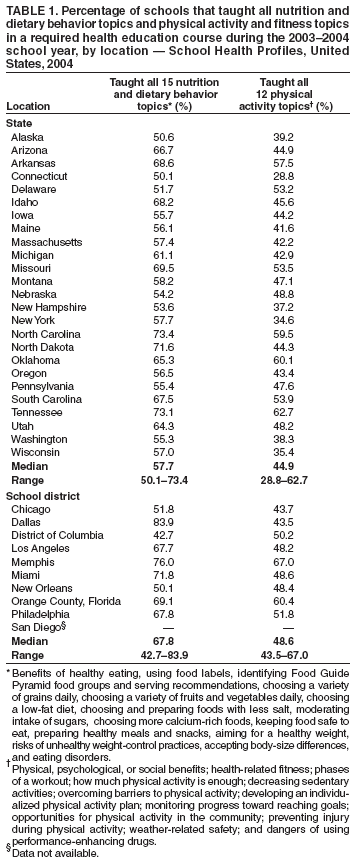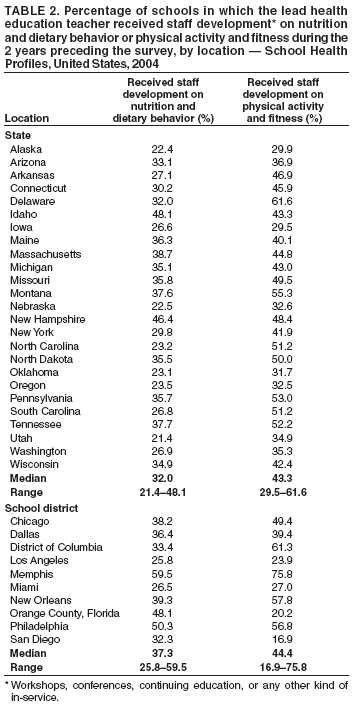 |
|
|
|
|
|
|
| ||||||||||
|
|
|
|
|
|
|
||||
| ||||||||||
|
|
|
|
|
Persons using assistive technology might not be able to fully access information in this file. For assistance, please send e-mail to: mmwrq@cdc.gov. Type 508 Accommodation and the title of the report in the subject line of e-mail. Secondary School Health Education Related to Nutrition and Physical Activity --- Selected Sites, United States, 2004Eating a healthful diet and engaging in physical activity have important health benefits for youths (1,2), such as reducing overweight, a condition that affected 17% of those aged 12--19 years during 2003--2004 (3). School health education that includes information about nutrition and physical activity is an important component of a comprehensive approach to improving dietary behavior, reducing sedentary behavior, and increasing physical activity among youths. A previous study suggested that professional development for health education teachers helps ensure the quality of health education instruction (4). To identify which nutrition and physical activity topics are being taught in school health education courses and what percentage of lead health education teachers have received professional development on nutrition and physical activity, CDC analyzed data from the 2004 School Health Profiles for public secondary schools (i.e., middle, junior high, and senior high schools) serving students in grades 6--12 in 25 states and 10 large urban school districts. This report summarizes the results of that analysis, which indicated that in 2004, approximately one half to three fourths of schools in the participating states and school districts taught all 15 nutrition and dietary behavior topics listed in the School Health Profiles questionnaire in a required health education course, and approximately one third to two thirds taught all 12 physical activity and fitness topics. State and local education agencies should continue to encourage schools to provide education on nutrition and physical activity as part of a coordinated school health program and promote staff development for health education teachers. Since 1994, the School Health Profiles survey has been conducted biennially by state and local education and health agencies to assess school health programs. State and local departments of education and health select either all public secondary schools within their jurisdictions or a systematic, equal-probability sample of public secondary schools to participate in the survey. At each school, separate questionnaires for the principal and lead health education teacher are both sent to the principal, who then designates which health education teacher will complete the teacher questionnaire. The questionnaires are self-administered and returned during the spring semester to the agency conducting the survey. Lead health education teachers are asked questions about the content of required health education courses and staff development on health education topics; the lists of 15 nutrition topics and 12 physical activity topics included in the School Health Profiles questionnaire are based on CDC guidelines (1,5) and the School Health Index (6). Follow-up telephone calls and written reminders are used to encourage participation. Data from each survey are weighted to reflect the likelihood of the school's being selected and to adjust for differing patterns of nonresponse. Results represent all public secondary schools in each jurisdiction. Results of principal questionnaires were not included in this analysis because they did not include information about the content of required health education classes. Participation in the School Health Profiles is confidential and voluntary. For the 2004 survey, lead health education teachers were asked the following questions:
In 2004, data from surveys of lead health education teachers were obtained from 25 states and 10 large urban school districts.* The 25 states were distributed across all regions of the United States, and four of the school districts were among the 10 largest in the country. Among states, the number of lead health education teachers who participated ranged from 58 to 581 per state (median: 254), and response rates ranged from 70.0% to 92.0% (median: 75.0%). Among large urban school districts, the number of lead health education teachers who participated ranged from 31 to 258 per school district (median: 50), and response rates ranged from 72.0% to 98.0% (median: 78.5%). The percentage of schools that provided any instruction on nutrition and dietary behavior in a required health education course ranged from 92.5% to 100.0% (median: 98.5%) among states and from 92.8% to 100.0% (median: 100.0%) among school districts. The percentage of schools that provided any instruction on physical activity and fitness in a required health education course ranged from 94.8% to 100.0% (median: 98.9%) among states and from 87.9% to 100.0% (median: 100.0%) among school districts. For each of 14 of the 15 nutrition and dietary behavior topics included in the questionnaire, the median percentage of schools that taught each topic in a required health education course ranged from 78.6% to 97.2% among states and from 82.0% to 98.8% among school districts. Medians for "keeping food safe to eat" were lower (74.3% among states and 81.1% among school districts). Fewer schools taught all 15 topics, with percentages ranging from 50.1% to 73.4% (median: 57.7%) among states and from 42.7% to 83.9% (median: 67.8%) among school districts (Table 1). For each of 10 of the 12 physical activity topics included in the questionnaire, the median percentage of schools that taught each one in a required health education course ranged from 70.4% to 94.4% among states and from 78.4% to 92.7% among school districts. Medians for "developing an individualized physical activity plan" and "monitoring progress toward reaching goals" were lower (69.8% and 62.8% among states, respectively, and 67.8% among school districts). The percentage of schools that taught all 12 topics ranged from 28.8% to 62.7% among states (median: 44.9%) and from 43.5% to 67.0% (median: 48.6%) among school districts (Table 1). The percentage of schools in which the lead health education teacher received staff development on nutrition and dietary behavior during the 2 years preceding the survey ranged from 21.4% to 48.1% (median: 32.0%) among states and from 25.8% to 59.5% (median: 37.3%) among school districts (Table 2). The percentage of schools in which the lead health education teacher received staff development on physical activity and fitness during the 2 years preceding the survey ranged from 29.5% to 61.6% (median: 43.3%) among states and from 16.9% to 75.8% (median: 44.4%) among school districts (Table 2). Reported by: ND Brener, PhD, L Kann, PhD, S Lee, PhD, ML McKenna, PhD, H Wechsler, EdD, Div of Adolescent and School Health; JE Fulton, PhD, DA Galuska, PhD, Div of Nutrition and Physical Activity, National Center for Chronic Disease Prevention and Health Promotion, CDC. Editorial Note:The findings in this report indicate that in 2004, nearly all secondary schools in 25 states and 10 large urban school districts provided education to students on nutrition and physical activity topics through required health education courses and taught key topics related to nutrition and physical activity. However, a lower proportion of schools taught all 15 nutrition and dietary behavior topics and all 12 physical activity and fitness topics included in the School Health Profiles questionnaire. Many of the topics listed in the questionnaire have been taught in classroom-based programs that have been determined to contribute to improving dietary behavior, increasing physical activity, reducing sedentary behavior, and reducing the prevalence of overweight among school-aged youths (1,5--7). This analysis also indicated that in most of the participating states and school districts, fewer than half of lead health education teachers had received recent staff development on nutrition and physical activity. Studies have indicated that teachers who receive staff development are more likely to cover a broader range of topics (8) and use teaching methods that have been determined to improve student health behaviors (4). States and school districts should increase the availability of staff development on nutrition and physical activity for health education teachers. The findings in this report are subject to at least three limitations. First, these data include only public secondary schools and therefore do not reflect practices at private schools. Second, these data were self-reported by lead health education teachers and are therefore subject to recall and other biases; the responses were not verified by other sources. Lead health education teachers might not be aware of the classroom practices of all individual health education teachers in the school. Finally, these data are not an assessment of the effectiveness of health education instruction. Schools should provide health education on nutrition and physical activity topics as one of several strategies to improve dietary behavior, increase physical activity, reduce sedentary behavior, and reduce overweight among youths (9). Classroom instruction should be part of a coordinated school health program that includes a healthy school meals program, healthy and appealing choices among foods and beverages offered in addition to the school meals program, a physical education program based on recommendations from the National Association for Sport and Physical Education in Moving into the Future: National Standards for Physical Education,§ opportunities for safe and enjoyable physical activity, school health services and counseling related to dietary behavior and physical activity, and a health promotion program for school staff members (1,5). CDC, in partnership with school administrators and staff, school health researchers, parents, and national nongovernmental health and education agencies, developed the School Health Index, a self-assessment and planning tool that schools can use to improve their health and safety policies and programs (6). Teachers, staff members, parents, students, and community members can use the School Health Index to assess whether their school curricula contain elements of effective health education on nutrition and physical activity topics and to create a plan to improve curricula and other components of their school health program. Acknowledgments This report is based on data collected by state and local School Health Profiles coordinators. References
* Secondary schools (i.e., middle, junior high, and senior high schools) serving students in grades 6--12 were surveyed in the following states and large urban school districts: states: Alaska, Arizona, Arkansas, Connecticut, Delaware, Idaho, Iowa, Maine, Massachusetts, Michigan, Missouri, Montana, Nebraska, New Hampshire, New York, North Carolina, North Dakota, Oklahoma, Oregon, Pennsylvania, South Carolina, Tennessee, Utah, Washington, and Wisconsin; school districts: Chicago, Illinois; Dallas, Texas; District of Columbia; Los Angeles, California; Memphis, Tennessee; Miami, Florida; New Orleans, Louisiana; Orange County, Florida; Philadelphia, Pennsylvania; and San Diego, California. Complete data on questions analyzed in this report are available at http://www.cdc.gov/healthyyouth/profiles/2004/report.pdf. § Available at http://www.aahperd.org/naspe. Table 1  Return to top. Table 2  Return to top.
Disclaimer All MMWR HTML versions of articles are electronic conversions from ASCII text into HTML. This conversion may have resulted in character translation or format errors in the HTML version. Users should not rely on this HTML document, but are referred to the electronic PDF version and/or the original MMWR paper copy for the official text, figures, and tables. An original paper copy of this issue can be obtained from the Superintendent of Documents, U.S. Government Printing Office (GPO), Washington, DC 20402-9371; telephone: (202) 512-1800. Contact GPO for current prices. **Questions or messages regarding errors in formatting should be addressed to mmwrq@cdc.gov.Date last reviewed: 8/3/2006 |
|||||||||
|